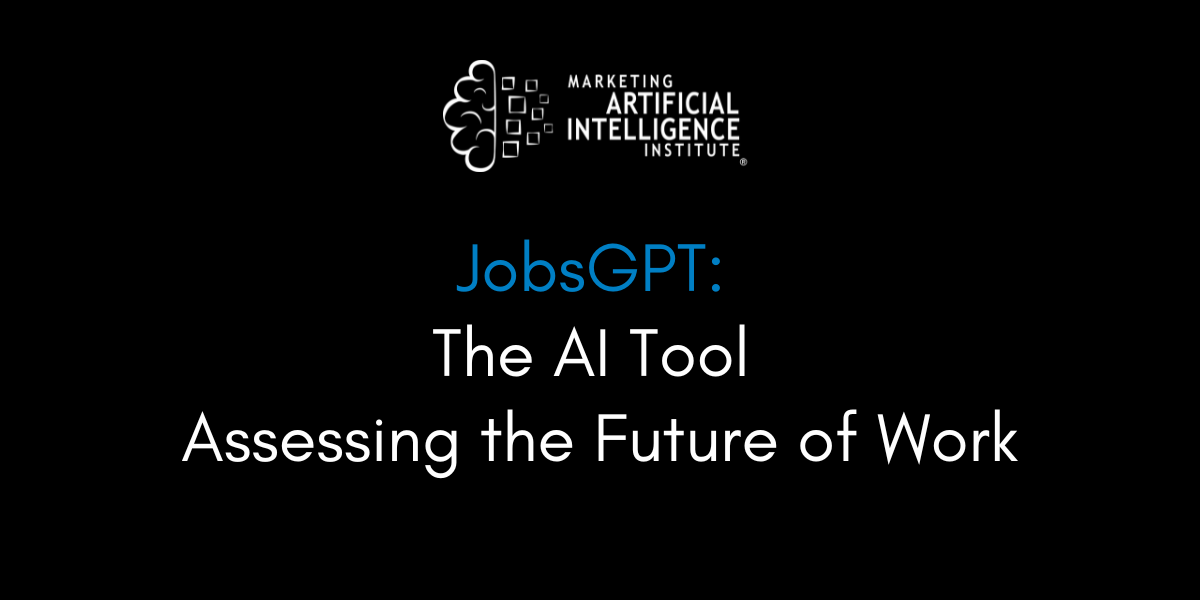In a world where AI capabilities are evolving at breakneck speed, understanding the potential impact on jobs and careers has never been more critical.
Enter JobsGPT, a new AI-powered tool designed to assess how large language models (LLMs) could reshape the future of work.
Developed by Paul Roetzer, founder and CEO of Marketing AI Institute and SmarterX, an AI research and consulting firm, JobsGPT gives any marketing or business professional the ability to see exactly how exposed their job is to AI transformation and disruption.
Roetzer broke down for me everything you need to know on Episode 110 of The Artificial Intelligence Show.
Keep reading to learn more. Or click the button below to use JobsGPT for yourself.
What is JobsGPT?
JobsGPT leverages advanced AI capabilities to break down your job into a collection of tasks, analyze the impact of AI on each task, and provide actionable insights to prioritize AI use cases and maximize your productivity.
You can just give JobsGPT the job title you want to assess, or give it a full job description with your actual tasks and responsibilities.
But here's the kicker: it doesn't just look at what AI can do today. It projects into the future, considering potential advancements in AI capabilities.
"We cannot plan our businesses or our careers or our next steps as a government based on today's capabilities," Roetzer emphasizes. "This is the number one flaw I see from businesses and from economists. They are making plans based on today's capabilities."
How It Works
Using JobsGPT is simple:
- Enter your job title or paste your job description.
- The tool breaks down your role into specific tasks.
- It then assesses each task based on different "exposure levels" to AI capabilities.
- You receive a chart showing potential time savings and rationale for each task.
Exposure Levels: A New Way to Think About AI Impact
JobsGPT uses a unique system of "exposure levels" to assess AI's potential impact.
Exposure means the ability for the LLM to reduce the time it takes to complete tasks with equivalent or greater quality than an average skilled professional.
- E0 – No exposure: LLM cannot reduce the time for this task. Typically requires high human interaction.
- E1 – Direct exposure: Direct access to the LLM reduces the time required.
- E2 – Exposure by LLM-powered applications: Additional software developed on top of the LLM, such as software that has access to CRM data and is able to write real-time summaries about customers and prospects.
- E3 – Exposure given image capabilities: LLM + ability to view, understand, caption, create, and edit images.
- E4 – Exposure given video capabilities: LLM + ability to view, understand, caption, create, and edit videos.
- E5 – Exposure given audio capabilities: LLM + ability to hear, understand, transcribe, translate, output audio, and have natural conversations through devices such as phones and computers.
- E6 – Exposure given advanced reasoning capabilities: LLM + ability to handle complex queries, solve multi-step problems, make more accurate predictions, understand deeper contextual meaning, complete higher-level cognitive tasks, draw conclusions, and make decisions.
- E7 – Exposure given persuasion capabilities: LLM + ability to convince someone to change their beliefs, attitudes, intentions, motivations, or behaviors.
- E8 – Exposure given digital world action capabilities (AI Agents): LLM + AI agents with the ability to interact with, manipulate, and perform tasks within digital environments just as a human would using a user interface such as a keyboard and mouse on a computer, or touch or voice on a smartphone.
- E9 – Exposure given physical world vision capabilities (AI Vision Devices): LLM + a physical device, such as phones or glasses, that enable the system to see, understand, analyze, and respond to the physical world.
- E10 – Exposure given physical world action capabilities (Humanoid Robots): LLM embodied in a general purpose, bi-pedal autonomous humanoid robot that enables the system to see, understand, analyze, respond to, and take action in the physical world.
Roetzer conceived the exposure levels as a variation on ones used in a seminal paper from OpenAI on how AI could impact jobs. The researchers also used the O*NET occupational database to look at AI’s impact on specific jobs—a dataset Roetzer also leveraged in JobsGPT.
“I could just input ‘marketing manager’ and it would build out the tasks based on its training data of what marketing managers do, and then it would assess it based on exposure levels of those tasks and how much time could be saved using a large language model with different capabilities,” says Roetzer.
“It's looking at your job, breaking it into a series of tasks, and then projecting out the impact of these models as the models get smarter and more generally capable.
Click the button below to use JobsGPT.
Mike Kaput
As Chief Content Officer, Mike Kaput uses content marketing, marketing strategy, and marketing technology to grow and scale traffic, leads, and revenue for Marketing AI Institute. Mike is the co-author of Marketing Artificial Intelligence: AI, Marketing and the Future of Business (Matt Holt Books, 2022). See Mike's full bio.




